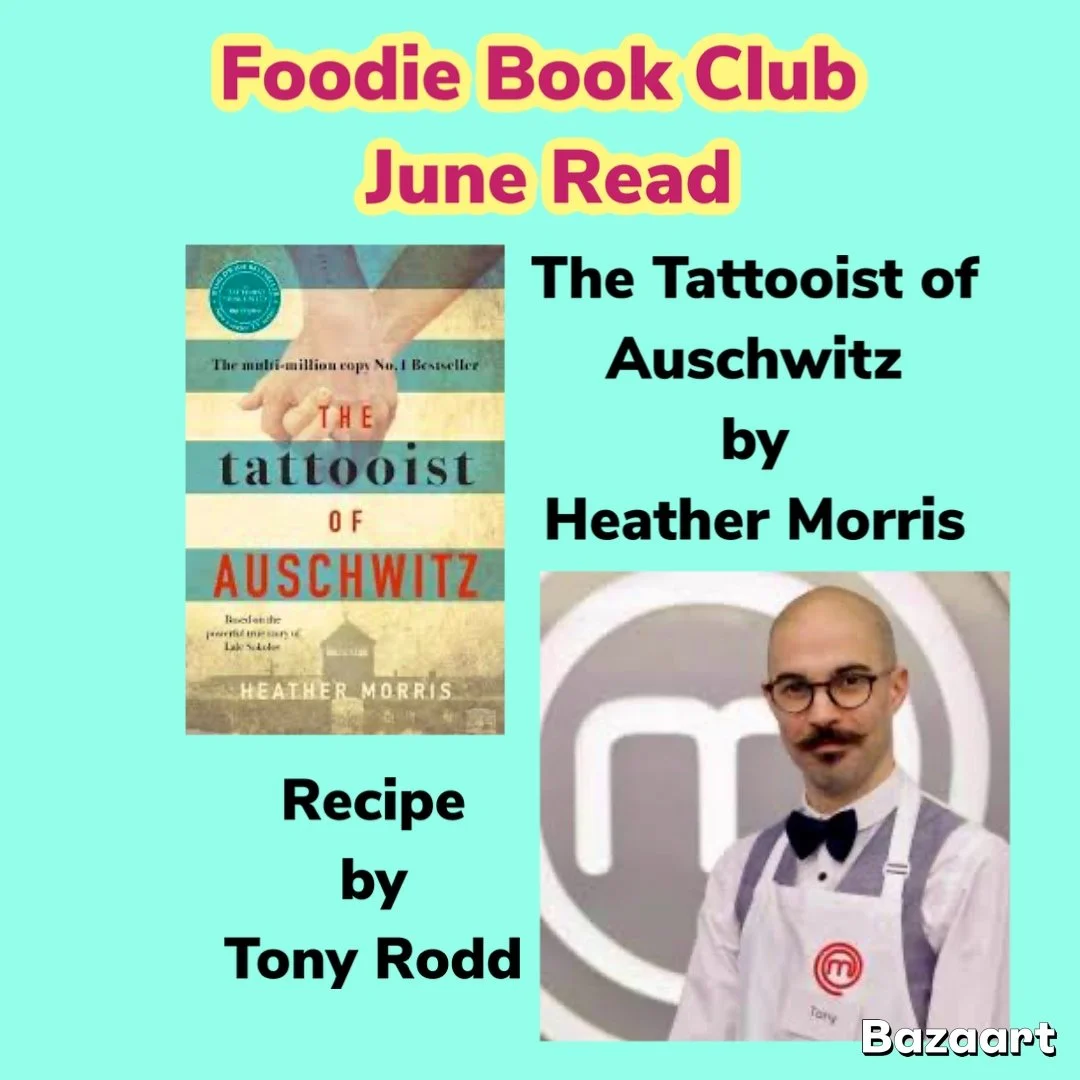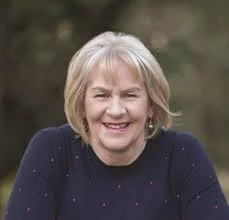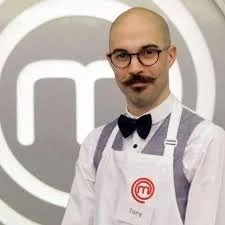The Tattooist of Auschwitz by Heather Morris, with Recipe by Chef Tony Rodd.
Author
Heather Morris has won way too many awards for me to list, so I’m not going to.
If you’d like to see them all, take a look at Heathers website.
Here’s the link.
Well, folks, let me tell you about Heather Morris—she’s one of those extraordinary women whose life story reads like a novel itself.
Born in 1978 in the vibrant, diverse land of South Africa, Heather’s early years were filled with a rich tapestry of cultures, stories, and traditions.
Growing up in a community teeming with life, she was surrounded by a kaleidoscope of voices and tales that would later influence her writing and storytelling style.
From a young age, Heather was captivated by the magic of stories—whether they came from books, people, or her own imagination—and she developed a deep love for reading and writing that would stay with her for life.
Her childhood was shaped by the social and political upheavals of South Africa during the late 20th century.
The country was navigating a complex path through apartheid and the struggle for freedom, and these turbulent times instilled in Heather a profound sense of resilience and empathy. She learned early on that stories could be powerful tools for understanding, healing, and connection.
These qualities—resilience, empathy, and a passion for storytelling—would become the hallmarks of her life and work.
But Heather’s journey wasn’t just about words and stories.
She was also a talented dancer and choreographer, a profession that took her far beyond the borders of South Africa.
Her dance career was vibrant and dynamic—she performed around the world, from small theatres to grand stages, and travelled extensively across continents.
These experiences exposed her to a multitude of cultures, people, and human stories. Traveling as a dancer gave Heather a unique perspective on life—she saw the beauty and pain, the hope and despair that exist in every corner of the globe.
It was during these travels that she developed a keen understanding of human emotion and resilience, insights that would later find their way into her novels.
Now, you might wonder how a dancer and choreographer transitions into a bestselling author.
Heather’s story is a testament to the idea that life’s journeys often lead us to unexpected places.
After years of performing and choreographing, she decided to channel her storytelling talents into writing.
Her first steps into the literary world weren’t easy—like many artists, she faced doubts, setbacks, and the challenge of finding her voice. But her passion for stories and her unwavering determination kept her moving forward.
After meeting Her big breakthrough came in 2018 with the publication of The Tattooist of Auschwitz.
Heather’s meticulous research made it an immediate bestseller, resonating deeply with audiences because it portrayed love, hope, and resilience amid unimaginable horrors.
It wasn’t just a story about suffering; it was a story about the human spirit’s capacity to endure and find light even in the darkest of times.
The success of The Tattooist of Auschwitz catapulted Heather into the literary spotlight.
She has become a major voice in historical fiction, celebrated for her ability to weave real-life stories with emotional depth and vivid detail.
Her subsequent books, Cilka’s Journey and Three Sisters, continued to explore themes of survival, love, and resilience, often inspired by real people and events.
Today, Heather Morris is not just a novelist; she’s a passionate advocate for literacy, education, and remembrance.
She travels extensively, participating in book tours, speaking engagements, and charitable events.
Her goal is to inspire others through her stories and to promote understanding and empathy across cultures and generations.
Heather believes in the transformative power of storytelling—how a well-told story can heal wounds, bridge divides, and foster compassion.
She often shares her own journey of resilience and perseverance, encouraging others to find their voice and tell their own stories.
Beyond her professional achievements, Heather is also a devoted family person.
She values her loved ones deeply and often speaks about the importance of family, kindness, and staying true to oneself.
Her personal life is a testament to her resilience—balancing her career, her passions, and her family with grace and humility.
She’s open about the challenges she’s faced along the way, emphasising that perseverance and a genuine love for what you do are key to overcoming obstacles.
Now living in the United States, Heather continues to write.
Author `heather Morris
Book
The Tattooist of Auschwitz was inspired by the true story of Lale Sokolov, a Jewish man who was forced to tattoo prisoners in Auschwitz during World War II.
It wasn’t just a story about suffering; it was a story about the human spirit’s capacity to endure and find light even in the darkest of times.
This is a powerful and deeply moving story set against the harrowing backdrop of World War II, specifically within the confines of Auschwitz concentration camp.
It follows Lale Sokolov, a Jewish man who finds himself caught in the chaos, brutality, and despair of one of history’s darkest chapters. Despite the unimaginable suffering surrounding him, Lale shows remarkable resilience, resourcefulness, and a compassionate spirit that refuses to be broken.
Lale’s role in the camp is to tattoo identification numbers on fellow prisoners—a task that is both physically and emotionally exhausting, constantly reminding him of the dehumanisation and loss of identity faced by so many. Yet, amid the bleakness and brutality, Lale’s inner strength and hope begin to shine through.
His life takes an unexpected turn when he falls in love with Gita, a woman also fighting to survive in the camp.
Their relationship becomes a beacon of hope and a testament to the enduring power of love in the face of unimaginable adversity.
The story explores themes of courage, resilience, and the unbreakable human spirit, illustrating how even in the darkest moments, acts of kindness, love, and hope can flourish.
It’s a story of survival not just in the physical sense, but also of the human soul’s capacity to find light amidst darkness.
This book serves as a poignant reminder that even in the worst of times, love and hope can shine through, inspiring us all with their enduring strength.
Tattooist of Auschwitz
My Thoughts
As I’m guessing I’m not the only one who read this book and was conflicted.
It took a while for me to get into this book, because of the subject matter, but not just because of the writing.
My dad was in a camp as a very young man, and even before starting the book, I was aware it would be a little triggering for me.
As I normally do, I listened to the book while going about my day-to-day stuff. I’m not sure if that was an advantage or not.
It was apparent that a lot of time was spent on research by the author, trying to stay true to the facts as she knew them and that was part of the book which interested me.
Sometimes uncomplicated is good, and the way the words fall on the page makes the narrative an easy read, which makes it a distinct comparison to the subject matter.
I found the two main characters (Lale and Gita) to be full, considering their situation, which kept me interested enough in them, to want to know more about their day-to-day happenings.
I did feel the more peripheral characters were a little weak to me, and I really wanted them to be broadened out and thickened with more context about what was happening for them during their time in the camp, instead it felt to me as though it was difficult for the writer, to juggle more than two narratives at once.
Overall, it was one of those books I felt I had to read at some stage in my life, and as it turned out, I’m glad I did. It’s not a book I would read for a second time, but it is one I would suggest other to take a look at.
I give it a 3 egg rating.
I give it a 3 Egg rating.
The Chef
Chef Tony Rodd is a British culinary talent who rose to prominence as a finalist on MasterChef in 2015. Known for his meticulous presentation and inventive desserts, he earned the nickname “The Master Chocolatier” during the competition
Before stepping into the culinary spotlight, Tony worked in recruitment.
His passion for cooking, rooted in family traditions and a love for food, led him to pursue a professional culinary career following his success on MasterChef. He began by hosting private dinners, supper clubs, and participating in food festivals across the UK.
In 2018, Tony and his wife Becky opened Copper & Ink in Blackheath, South East London. The restaurant offered modern British cuisine with seasonal tasting menus and live music. Despite its acclaim, the restaurant faced financial challenges exacerbated by the COVID-19 pandemic, rising energy costs, and economic pressures, leading to its closure in early 2024.
After closing Copper & Ink, Tony relocated to Margate and partnered with hospitality entrepreneur Ryan Jacovides to open Pomus, a neighborhood-style restaurant and wine bar. The menu emphasized low-waste, gluten-free dishes using local Kentish produce.
Tony later stepped away from Pomus to launch his own venture, Fifteen Square Metres, in Broadstairs, where he continues to focus on seasonal, sustainable cooking.
Tony's cooking style is modern European, influenced by French and British classics.
He is particularly renowned for his desserts, often incorporating chocolate work.
His approach emphasizes seasonality, sustainability, and drawing inspiration from various world cuisines, including Japanese and Scandinavian.
Tony first gifted this recipe for Foodie Book Clubs Lockdown Lunches series when everyone was locked up tight during the pandemic.
Tony and his wonderful wife Becky, have always been supporters of Foodie Book Club and what we do for the community, so when asked to gift us a recipe and to record a live demonstration for our YouTube channel, said an immediate yes.
I’ve revived the recipe here, and if you want to click this link, you can see Tony cooking it live.
Find out what Tony is cooking in his restaurant, Fifteen Square Metres - Here’s the link.
Chef Tony Rodd
Recipe
Quinoa Risotto, Wild Mushrooms and Chicken Thigh (Serves 2)
Ingredients
60g white quinoa
60g red quinoa
250ml water
1 veg stock cube
70g dried mushrooms
1 ltr boiling water
10ml truffle oil (optional)
50g crème fraiche
50g grated parmesan
50g unsalted butter
2 chicken thighs (skin on, boneless)
Method
Start by softening down the mushrooms by placing 50g of the mushrooms in the boiling water.
Next start cooking the quinoa. Put the veg stock and water in a saucepan and bring to the boil, ensuring the stock is fully dissolved. Add the quinoa, bring back to the boil, turn right down to low and cover. Leave for 15 minutes.
Take the remaining dried mushrooms and blitz them in a food processor or blender to a powder. You can use a pestle and mortar and a pinch of coarse salt.
In a good, non stick pan, heat a little rapeseed oil over a medium heat. Season your chicken with the mushroom powder and a pinch of salt.
Place the chicken, skin side down, in the pan.
Cook for 4-5 minutes or until the skin is crispy and golden.
Flip and cook on the other side for a few minutes. Remove from the pan onto a board to rest.
Drain your quinoa and place in a clean saucepan with some truffle oil, or normal oil if you prefer.
Cook over a medium heat along with the crème fraiche and parmesan.
Add in the, now softened, wild mushrooms and cook for a few minutes.
Finally, add the butter and taste, adding salt if required.
Place a generous spoon of the risotto in a bowl, slice the chicken, laying it over the risotto.







